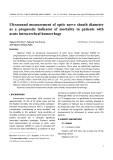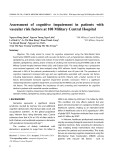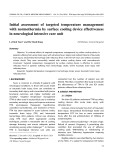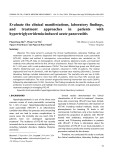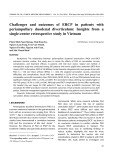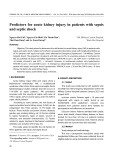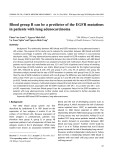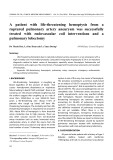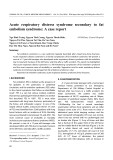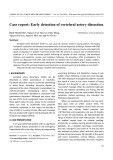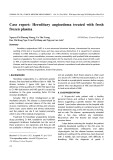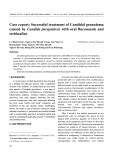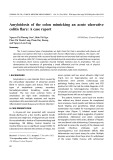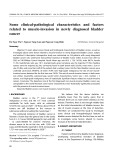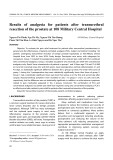Inhibition of PI3K/Akt partially leads to the inhibition of PrPC-induced drug resistance in gastric cancer cells Jie Liang*, Fulin Ge*, Changcun Guo, Guanhong Luo, Xin Wang, Guohong Han, Dexin Zhang, Jianhong Wang, Kai Li, Yanglin Pan, Liping Yao, Zhanxin Yin, Xuegang Guo, Kaichun Wu, Jie Ding and Daiming Fan
State Key Laboratory of Cancer Biology and Xijing Hospital of Digestive Diseases, Fourth Military Medical University, Xi’an, Shaanxi, China
Keywords drug resistance; gastric cancer; P-gp; PI3K/Akt; prion protein
Correspondence J. Ding, State Key Laboratory of Cancer Biology and Xijing Hospital of Digestive Diseases, Fourth Military Medical University, Xi’an 710032, China Fax: +86 29 82539041 Tel: +86 29 84771504 E-mail: dingjie@fmmu.edu.cn D. Fan, State Key Laboratory of Cancer Biology and Xijing Hospital of Digestive Diseases, Fourth Military Medical University, Xi’an 710032, China Fax: +86 29 82539041 Tel: +86 29 84775221 E-mail: fandaim@fmmu.edu.cn
*These authors contributed equally to this work
Cellular prion protein (PrPC), a glycosyl-phosphatidylinositol-anchored membrane protein with unclear physiological function, was previous found to be upregulated in adriamycin (ADR)-resistant gastric carcinoma cell line SGC7901/ADR compared to its parental cell line SGC7901. Overexpres- sion of PrPC in gastric cancer has certain effects on drug accumulation through upregulation of P-glycoprotein (P-gp), which is suggested to play an important role in determining the sensitivity of tumor cells to chemo- therapy and is linked to activation of the phosphatidylinositol-3-kinase/Akt (PI3K/Akt) pathway. In the present study, we further investigate the role of the PI3K/Akt pathway in PrPC-induced multidrug-resistance (MDR) in gastric cancer. Immunohistochemistry and confocal microscope detection suggest a positive correlation between PrPC and phosphorylated Akt (p-Akt) expression in gastric cancer. Using established stable PrPC transfec- tant cell lines, we demonstrated that the level of p-Akt was increased in PrPC-transfected cells. Inhibition of PrPC expression by RNA interference resulted in decreased p-Akt expression. Inhibition of the PI3K/Akt path- way by one of its specific inhibitors, LY294002, or by Akt small interfering RNA (siRNA) resulted in decreased multidrug resistance of SGC7901 cells, partly through downregulation of P-gp induced by PrPC. Taken together, our results suggest that PrPC-induced MDR in gastric cancer is associated with activation of the PI3K/Akt pathway. Inhibition of PI3K/Akt by LY2940002 or Akt siRNA leads to inhibition of PrPC-induced drug resis- tance and P-gp upregulation in gastric cancer cells, indicating a possible novel mechanism by which PrPC regulates gastric cancer cell survival.
(Received 1 October 2008, revised 16 November 2008, accepted 24 November 2008)
is localized at
following activities: neurotransmitter metabolism, cell adhesion, signal transduction, antioxidant activity and programmed cell death [2]. However, the exact biologi- cal function of normal PrPC is still unknown [3].
Cellular prion protein (PrPC) is a ubiquitous glyco- the cell surface via a protein that glycosyl-phosphatidylinositol-anchored membrane pro- tein, whose pathogenic isoform, PrPSc, has attracted worldwide attention due to its involvement in the path- ogenesis of bovine spongiform encephalopathy and Creutzfeldt–Jakob disease in human beings [1]. PrPC is highly conserved in mammalian species, and has been postulated to be involved in one or more of the
In our previous studies, PrPC was identified as an upregulated gene in the adriamycin (ADR)-resistant gastric carcinoma cell line SGC7901/ADR compared to its parental cell line SGC7901 by subtractive hybrid- ization and RT-PCR [4]. PrPC was further found to be
doi:10.1111/j.1742-4658.2008.06816.x
FEBS Journal 276 (2009) 685–694 ª 2008 The Authors Journal compilation ª 2008 FEBS
685
Abbreviations ADR, adriamycin; IR, immunoreactivity; MDR, multidrug-resistance; MTT, 3-(4,5-dimethylthiazol-2-yl)-2,5-diphenyl-tetrazolium bromide; P-gp, P-glycoprotein; PI3K/Akt, phosphatidylinositol-3-kinase/Akt; PrPC, cellular prion protein; siRNA, small interfering RNA; VCR, vincristine.
cell
cancer
was a significant correlation between PrPC and p-Akt immunoreactivity, with rs = 0.514, P < 0.01 (Fig. 1A). The correlation of p-Akt with PrPC in gastric cancer tissues suggests possible co-expression.
To test
resistance
lines highly expressed in the gastric SGC7901/ADR and SGC7901/VCR. Its overexpres- sion played a certain role in drug accumulation in gastric cancer cells, which could induce drug resistance in SGC7901 cells by decreasing accumulation and increasing release of these drugs (ADR and VCR) [5]. PrPC-mediated multidrug (MDR) was thought to be related to upregulation of P-glycoprotein (P-gp) [6] and inhibition of apoptosis [6–9]; these stud- ies were the first reports that PrPC can induce the MDR phenotype in gastric cancer cells.
this hypothesis, PrPC and p-Akt were co-expressed in SGC7901/ADR cells. The yellow stain- ing in dual-labeling experiments indicated overlapping areas of suggesting red and green fluorescence, co-expression of p-Akt with PrPC in the cytoplasm of SGC7901/ADR cells (Fig. 1B). These results suggested a positive correlation between PrPC and p-Akt expres- sion in gastric cancer.
Induced activation of p-Akt in PrPC-transfected cells
line MCF7,
cancer
cell
Activation of the phosphatidylinositol-3-kinase/Akt (PI3K/Akt) pathway is a critical step in determining the sensitivity of tumor cells to chemotherapy [10]. A previous study demonstrated that MDR in gastric cancer could be reversed by downregulation of Akt1 by Akt1 small interfering RNA (siRNA) [11]. Other studies strongly suggested that the PI3K/Akt path- way is involved in certain functions of PrP [12,13]. Some differentially expressed genes involved in the PI3K/Akt pathway were found to be overexpressed together with in breast 17-fold upregulation of PrP [14].
(Thr308)
In present study, we hypothesized that the PI3K/Akt pathway is involved in PrPC-mediated MDR in gastric cancer. To test this hypothesis, the expression of Akt and PrPC was examined by immunohistochemistry and confocal microscope in human gastric cancer cases and cell lines. Expression of total and p-Akt was detected in cells transfected with PrPC. The effects of PI3K/Akt on PrPC-induced MDR in gastric cancer were then exam- ined by a drug sensitivity assay that involved adding the PI3K/Akt-specific inhibitor LY294002 or co-transfec- tion with Akt siRNA. The underlying mechanisms were further explored by RT-PCR, Western blotting and the luciferase reporter assay.
J. Liang et al. PI3K/Akt in PrPC-induced MDR
Results
Co-expression of PrPC and Akt in gastric cancer
Our previous work has shown that PrPC expression was detected in several different histological types of human gastric cancer cell lines, and is relatively low in SGC7901 cells and high in AGS. To upregulate or downregulate PrPC expression, the PRNP gene was stably transfected into human gastric cancer cells of line SGC7901 or blocked by siRNA in AGS. After cell transfection and antibiotic screening for more than 2 months, multiple resistance clones were selected, and expression of PrPC in the cells was confirmed by Wes- tern blotting (Fig. 2A). As close correlation of p-Akt with PrPC was found in gastric cancer tissues, we won- dered whether PrPC could regulate the expression of Akt in transfected cells. As shown in Fig. 2B, there was higher expression of the phosphorylated form of in SGC7901 transfected with PrPC Akt (SGC7901/PrPC) than in SGC7901 transfected with empty pcDNA3.1B (SGC7901/pcDNA3.1B) or non- transfected SGC7901, which did not affect the expres- sion of total Akt. As the siRNA affected translation but not post-translational events, both the total and levels decreased in AGS/PrPC phosphorylated Akt (RNAi). These results indicate that alteration of PrPC expression led to a corresponding change in the PI3K/ Akt pathway in gastric cancer cells lines, and con- firmed that PrPC regulates the expression of p-Akt in vitro, consistent with the above in vivo findings.
PI3K/Akt is involved in PrPC-mediated MDR in gastric cancer
(p-Akt)
Immunohistochemical staining showed that PrPC was expressed in the cytoplasm of neoplastic cells in 70.6% (60/85) of gastric cancer tissues. Although PrPC also showed expression in adjacent nontumor gastric tissue, this was significantly lower than in gastric cancer cells (P < 0.05). Phosphorylated Akt immuno- reactivity was observed in 88.2% (75/85) of gastric cancer tissues, with positive signals mainly in the cyto- plasm of neoplastic cells. As PrPC and p-Akt expres- sion coexisted in gastric cancer tissues, we analyzed their correlation in 60 cases of PrPC-positive gastric cancer tissues. Spearman analysis showed that there
In order to study whether activation of the PI3K/Akt signaling pathway played a role in PrPC-induced MDR in gastric cancer cells, the PrPC-overexpressing cell line and the corresponding controls were treated with LY294002, a selective inhibitor of PI3K, or by co-transfection with Akt siRNA [13]. The in vitro
FEBS Journal 276 (2009) 685–694 ª 2008 The Authors Journal compilation ª 2008 FEBS
686
J. Liang et al. PI3K/Akt in PrPC-induced MDR
A (a)
(b)
(c)
B
(a)
(b)
(c)
(d)
or 0.2 lg Akt siRNA. The releasing index also decreased more sharply at 10 lm LY294002 or 0.2 lg Akt siRNA in SGC7901/PrPC. The highest concentra- tions of LY294002 (40 lm) or Akt siRNA (1 lg) resulted in similar releasing rates to each other because of their toxicity effect (P > 0.05) (Fig. 3). The results indicated that inhibition of the PI3K/Akt signaling pathway leads to inhibition of PrPC-induced cell drug resistance in gastric cancer cells.
PI3K/Akt is involved in the activation of P-gp by PrPC in gastric cancer
inhibitory
rate
in
effects of the anticancer drugs on the growth of SGC7901/PrPC, SGC7901/pcDNA3.1B and SGC7901 evaluated by the 3-(4,5-dimethylthiazol-2-yl)- were 2,5-diphenyl-tetrazolium bromide (MTT) assay. As shown in Table 1, in the absence of LY294002 or Akt siRNA, the control and parental cells showed higher sensitivity to ADR and VCR than adding LY294002 or Akt siRNA. However, the inhibitory rate in cells transfected with PrPC was significantly different to that in control cells (P < 0.05). When the cells were treated with a high dose of the inhibitor LY294002 (40 lm) or co-transfected with Akt siRNA (1 lg) for 24 h, the SGC7901/PrPC was relative decreased to levels similar to the controls because of their toxicity in cell death (P > 0.05).
cells were
accumulation
retention
and
of
The effects of LY294002 on adriamycin accumula- tion and retention in SGC7901/PrPC cells were further determined by flow cytometric analysis. The adria- mycin-releasing index in gastric cancer SGC7901 cells was calculated as follows: releasing index = (accumu- lation value ) retention value)/accumulation value. The results showed less adriamycin accumulation and retention in SGC7901/PrPC cells compared with that treated with in controls. When the LY294002 or co-transfected with Akt siRNA for 24 h, the adriamycin increased in both cell lines, but was more significant in SGC7901/PrPC (P < 0.05). The above results indi- cated a partly dose-dependent effect, but the effect more significant at concentrations of 10 lm LY294002
To further investigate the underlying mechanism of PI3K/Akt-mediated PrPC-induced gastric cancer MDR, the PrPC-overexpressing cell lines (SGC7901/PrPC) and corresponding controls (SGC7901/pcDNA) were trea- ted with LY294002 or Akt siRNA to screen the down- stream molecules. PrPC-transfected gastric cancer cells were treated with LY294002 (10 lm) or Akt siRNA (0.2 lg), and exhibited downregulation of P-gp at both the mRNA and protein levels (Fig. 4A). Inhibition of the PI3K/Akt pathway decreased the expression of P-gp induced by PrPC at both the mRNA and protein levels, suggesting transcriptional regulation of P-gp by PI3K/ Akt in PrPC-transfected gastric cancer cells. Therefore, the promoter sequence of MDR-1 ()136 to 10) was reporter assay was luciferase amplified, and the performed to investigate the transcriptional regulation of P-gp by PI3K/Akt. The luciferase activity of P-gp
FEBS Journal 276 (2009) 685–694 ª 2008 The Authors Journal compilation ª 2008 FEBS
687
Fig. 1. Co-expression of PrPC and Akt in gastric cancer. (A) Serial sections of gastric cancer tissue were stained with antibodies against PrPC (3F4, Sigma) or p-Akt (Thr 308; Cell Signaling Technology). (a) Gastric can- cer tissue stained with anti-p-Akt (Thr 308). (b) Gastric cancer tissue stained with anti- PrPC. (c) Negative control (original magnifica- tion, ·200). (B) Co-expression of PrPC with p-Akt in SGC7901/ADR cells. (a) Confocal microscopic imaging of p-Akt, stained with monoclonal antibody against p-Akt and FITC- conjugated goat anti-mouse IgG (green). (b) Confocal microscopic imaging of PrPC, stained with polyclonal antibody against PrP (Santa Cruz Biotechnology) and tetraethyl rhodamine isothiocyanate-labeled rabbit anti- goat IgG (red). (c) Co-expression of p-Akt with PrPC results in yellow staining. (d) Co-expression of p-Akt with PrPC, with nuclear staining by 4¢,6-diamidino-2-phenylin- dole (DAPI) (blue) (original magnification, ·400).
J. Liang et al. PI3K/Akt in PrPC-induced MDR
A
transfected with PrPC showed significantly decreased P-gp promoter activity compared with the control cells (SGC7901/pcDNA and SGC7901 cells) after addition of LY294002 or co-transfection with Akt siRNA (Fig. 4B). PI3K/Akt might therefore be involved in transcriptional activation of P-gp in gastric cancer cells transfected with PrPC. Inhibition of the PI3K/Akt path- way by its specific inhibitor or Akt siRNA could reverse the PrPC-induced MDR effect, partly through decreas- ing transcriptional activation of P-gp.
Discussion
B
In the present study, we present the first evidence that PI3K/Akt may be involved in the transcriptional acti- vation of P-gp in gastric cancer cells transfected with PrPC. Inhibition of the PI3K/Akt pathway by its spe- cific inhibitor or Akt siRNA reverses PrPC-induced MDR in gastric cancer cells, partly by decreasing the transcriptional activation of P-gp. Continuing from our previous work, it further reveals the function of PrPC in the MDR of cancers.
line [5]. However,
Over recent years, many investigations have focused on the physiological and pathological processes of PrPC [3]. Recently, PrPC has been reported to play a positive role in MDR of many types of human cancers [15]. Levenson et al. [16] analyzed cell lines in which MDR had been induced by genetic suppressor ele- ments of cDNA array hybridization, and found that the transcription level of PrPC was increased. Our pre- vious studies had shown that PrPC is ubiquitously expressed in gastric carcinoma cell lines and tissues but is weakly or not expressed in normal gastric mucosa [6,7,9,13]. In vitro and in vivo drug sensitivity assays indicated that PrPC could promote the drug resistance of a gastric cancer cell little is known about the molecular mechanism involved in this process.
promoter in gastric cancer cells decreased with or with- out PrPC transfection by adding LY294002 or co-transfection with Akt siRNA. However, SGC7901
Fig. 2. The inducible effect of PrPC on Akt. (A) Western blot analy- sis of the cells transfected with the empty vector or with PrPC. b-actin was used as a loading control. (B) Expression of p-Akt and total Akt were determined in gastric cancer cells by Western blot. b-actin was used as an internal control. Autoradiograms were quantified by densitometry and p-Akt protein levels were calculated relative to the amount of b-actin protein.
Table 1. IC50 values (lgÆmL)1) for anticancer drugs for gastric cancer cells. Survival rates of gastric cancer cells treated with anticancer drugs were evaluated by the MTT assay as described in Experimental procedures. Dose–effect curves for the anticancer drugs were plotted on semi-logarithmic coordinate paper, and IC50 values were determined. Data are means ± SD of three independent experiments.
Akt siRNA (lg) LY294002 (lM)
0 10 20 40 0 0.2 0.4 1 Cell lines
Adriamycin
SGC7901/PrPC SGC7901/pcDNA3.1B SGC7901 6.87 ± 0.79 0.43 ± 0.03 0.31 ± 0.03 4.12 ± 0.64 0.37 ± 0.05 0.29 ± 0.04 2.58 ± 0.34 0.28 ± 0.02 0.25 ± 0.03 0.84 ± 0.17 0.20 ± 0.03 0.19 ± 0.02 6.87 ± 0.79 0.43 ± 0.03 0.31 ± 0.03 4.92 ± 0.74 0.38 ± 0.06 0.32 ± 0.05 3.76 ± 0.49 0.30 ± 0.03 0.26 ± 0.02 1.39 ± 0.25 0.24 ± 0.04 0.22 ± 0.04 Vincristine
FEBS Journal 276 (2009) 685–694 ª 2008 The Authors Journal compilation ª 2008 FEBS
688
SGC7901/PrPC SGC7901/pcDNA3.1B SGC7901 7.38 ± 0.78 0.24 ± 0.02 0.14 ± 0.02 5.21 ± 0.56 0.20 ± 0.03 0.12 ± 0.04 2.69 ± 0.38 0.17 ± 0.02 0.10 ± 0.03 0.34 ± 0.21 0.09 ± 0.01 0.08 ± 0.02 7.38 ± 0.78 0.24 ± 0.02 0.14 ± 0.02 5.83 ± 0.59 0.22 ± 0.06 0.13 ± 0.05 3.16 ± 0.43 0.18 ± 0.04 0.11 ± 0.04 0.83 ± 0.35 0.12 ± 0.03 0.09 ± 0.02
J. Liang et al. PI3K/Akt in PrPC-induced MDR
A
B
P < 0.05
SGC7901/PrP SGC7901/pcDNA
P < 0.05
P < 0.05
30
P > 0.05
P > 0.05
P > 0.05
SGC7901/PrP SGC7901/pcDNA
25
P < 0.05
20
P > 0.05
i
15
l
10
x e d n i g n s a e e R
5
l
y t i s n e t n i e c n e c s e r o u F
0.45 0.4 0.35 0.3 0.25 0.2 0.15 0.1 0.05 0
0
0 µM
10 µM
20 µM
40 µM
0 µM
10 µM
20 µM
40 µM
LY294002
LY294002
SGC7901/PrP SGC7901/pcDNA
P < 0.05
25
P < 0.05
P > 0.05
P < 0.05 P > 0.05
P < 0.05
P > 0.05
SGC7901/PrP SGC7901/pcDNA
20
P > 0.05
15
i
10
l
x e d n i g n s a e e R
5
l
y t i s n e t n i e c n e c s e r o u F
0.45 0.4 0.35 0.3 0.25 0.2 0.15 0.1 0.05 0
0
0 µg
0.2 µg
0.4 µg
1 µg
0 µg
0.2 µg
0.4 µg
1 µg
siRNA of Akt
siRNA of Akt
Fig. 3. Fluorescence intensity and releasing index of adriamycin in gastric cancer cells. Gastric cancer cells were treated with or without LY294002 (10, 20 or 40 lM) or co-transfected with Akt siRNA (0.2, 0.4 or 1 lg) for 24 h. Adriamycin was added to cells in log phase to a final concentration of 5 lgÆmL)1. After 1 h, cells were harvested (for detection of adriamycin accumulation) or cultured in drug-free RPMI- 1640 for another 30 min, followed by harvesting (for detection of adriamycin retention). The fluorescence intensity of intracellular adriamycin was determined using flow cytometry with an excitation wavelength of 488 nm and an emission wavelength of 575 nm. (A) Fluorescence intensity analysis of intracellular adriamycin in gastric cancer cells. (B) Adriamycin releasing index of gastric cancer cells. The releasing index = (accumulation value ) retention value)/accumulation value.
A
B
FEBS Journal 276 (2009) 685–694 ª 2008 The Authors Journal compilation ª 2008 FEBS
689
Fig. 4. PI3K/Akt is involved in the activation of P-gp by PrPC in gastric cancer. (A) Expression of P-gp at both the mRNA and protein levels was investigated in PrPC-transfected gastric cancer cells treated with LY294002 (10 lM) or Akt siRNA (0.2 lg). b-actin was used as a loading control. Autoradiograms were quantified by densitometry, and gene or protein levels were calculated relative to the amount of b-actin gene or protein. (B) Luciferase reporter assay to determine the regulatory effect of PI3K/Akt on MDR-1 promoter activity in PrPC-transfected cells. A dual luciferase system was used in this assay. The promoter activity was measured in terms of relative luminescence units (RLU), calculated using the following formula: RLU = luminescence intensity of the Firefy luciferase/luminescence intensity of the Renilla luciferase. Control, cells co-transfected with empty pcDNA3.1 vector or parental cells SGC7901, pGL-MDR vector and pRL-TK vector; PrPC, cells co-transfected with empty pcDNA3.1B/PrPC vector treated with or without LY294002 (10 lM) or Akt siRNA (0.2 lg), pGL-MDR vector and pRL-TK vector. The luciferase activities of each reporter plasmid were measured in triplicate and are expressed as fold inductions after normalization.
physically associate with Fyn to transducing differen- tiation signals [24]. It has also been demonstrated that constitutively activated PI3K enhances activation of the MDR-1 promoter by 2-acetylaminofluorene [25].
In the present study, we report for the first time that activation of PI3K/Akt signaling pathway plays an essential role in PrP-induced MDR in gastric cancer cells. Inhibition of the PI3K/Akt signaling pathway by LY2940002 or Akt siRNA leads to inhibition of PrPC- induced cell drug resistance and P-gp upregulation in gastric cancer cells, which indicated a possible novel mechanism by which PrPC regulates gastric cancer cell survival.
Multidrug resistance (MDR) is one of the major causes of failure of chemotherapy of human malignan- cies. Studies have shown that cellular drug resistance is mediated by various mechanisms operating at various steps in the cytotoxic activity of the drug, from a decrease of drug accumulation in the cell to abrogation of apoptosis induced by the chemical substance. Often several different mechanisms were switched on in the cells, but usually one major mechanism was operating. MDR-1 (ABCB1, P-glycoprotein) is known to signifi- cantly alter the extent of drug absorption and excre- tion, which play a key role in the MDR of cancers [17]. Previous studies identified P-gp as an important molecule in gastric cancer [4–6,18–20] and leukemia MDR [20].
J. Liang et al. PI3K/Akt in PrPC-induced MDR
Experimental procedures
PI3K/Akt signal
Antibodies and reagents
inhibition of
SP-9000 Histostain-Plus kits were obtained from Zhong- shan Goldbridge Biotechnology (Beijing, China). The drugs vincristine (VCR) and adriamycin (ADR) were purchased from Farmitalia Carlo Erba (Milan, Italy) and Minsheng Pharmaceutical Company (Hangzhou, China), respectively. The antibodies rabbit anti-human t-Akt, mouse anti-human p-Akt and mouse anti-human P-gp, and the PI3K/Akt- specific inhibitor LY294002 were obtained from Cell Signal- ing Technology (Beverly, MA, USA). Mouse anti-human monoclonal PrPC serum (3F4) was purchased from Sigma (St Louis, MO, USA) and rabbit anti-human polyclonal PrP was purchased from Santa Cruz Biotechnology (Santa Cruz, CA, USA). The Sp1 immunohistochemistry kit and fluorescein isothiocyanate (FITC)-labeled goat anti-rabbit and goat anti-mouse IgG were purchased from Zhongshan Goldbridge Biotechnology (Beijing, China).
transduction pathway has been reported to be involved in the neuroprotective effect of humanin on cerebral ischemia/reperfusion injury [21]. Activation of the PI3K/Akt pathway is one of the critical steps in cell survival and MDR [22]. The present study focuses on whether the PI3K/Akt path- way contributes to the PrPC-induced MDR phenotype in gastric cancer cells. We show that PrPC and Akt are co-expressed in gastric carcinoma, and whose expression was related to MDR in gastric cancer. PrPC-transfected cell lines showed increased expression of phosphorylated Akt, indicating that PrP may serve as a positive upstream regulator of PI3K/Akt in gastric cancer cells. By inhibiting the PI3K/Akt pathway using the LY294002 or co-transfection with Akt siRNA, drug sensitivity and accumulation in SGC7901/PrPC cells were significantly increased. The results indicate that the PI3K/Akt signaling pathway may lead to inhibition of the MDR induced by PrPC in gastric cancer cells.
Clinical samples
tissue was used for
(34 females, 51 Eighty-five gastric carcinoma patients range 29–78 years) males; mean age 56.1 ± 11.5 years; were included from a population-based case-controlled study conducted in Xijing Hospital, Xi’an, China. Patients whose surgical the study signed informed consent. All cases of gastric cancer were clini- cally and pathologically proved. The protocols used in the study were approved by the hospital’s Protection of Human Subjects Committee. Formalin-fixed paraffin- embedded tissue sections were retrieved from archives at the Department of Pathology. Demographic and clinico- pathological information was obtained from our popula- tion-based database, and tumor staging was carried out for each case according to the classification at the time of surgery. Thirty cases were classified as well-differentiated, 43 as moderately differentiated and 12 as poorly differen- tiated gastric cancers.
The mechanism underlying PI3K/Akt-mediated PrPC-induced MDR in gastric cancer was further inves- tigated. PrPC-transfected gastric cancer cell lines and corresponding controls were treated with LY294002 or Akt siRNA as described previously [6]. PrPC-transfected cells treated with an inhibitor of Akt exhibited downre- gulation of P-gp at both the mRNA and protein levels; this was proven to be due to transcriptional inhibition of MDR-1 using a luciferase reporter assay. Thus the PI3K/Akt pathway may be involved in transcriptional activation of P-gp in PrPC-transfected gastric cancer cells, inhibition of which would reverse gastric cancer MDR, partly by decreasing the transcriptional activa- tion of P-gp. This model of a PrPC/PI3K/P-gp signal agrees with other reported findings on prion protein sig- naling. It was found that the Fyn protein governed a number of the PrPC-induced pathways that converged to the PI3K module in neurons [23]. PI3K is known to
FEBS Journal 276 (2009) 685–694 ª 2008 The Authors Journal compilation ª 2008 FEBS
690
Immunohistochemistry analysis
newborn bovine serum (SiJiQing, Hangzhou. China) at 37(cid:2) C in a humidified atmosphere of 5% CO2 and 95% air.
Double immunofluorescence staining
Tissue sections from gastric carcinoma were immunostained using SP-9000 Histostain-Plus kits. The slides were depa- raffinized, rehydrated, blocked and then primary antibody was added as described previously [7]. Biotinylated goat anti-mouse IgG was applied to the cell sections, which were then incubated at room temperature for 30 min. After washing with NaCl/Pi for 10min, the tissues were incubated with avidin dehydrogenase/biotinylated peroxidase for 30 min. Color was developed by immersion of the sections in a peroxidase substrate diaminobezidin solution.
Evaluation of immunostaining
Double immunostaining for antigen co-localization was per- formed using FITC-conjugated goat anti-mouse IgG (Chem- icon, Billerica, MA, USA; 1 : 80) and tetraethylrhodamine IgG (Chemicon, isothiocyanate-labeled rabbit anti-goat 1 : 100). Cells were nuclear-stained using 4¢,6-diamidino-2- phenylindole (DAPI). The primary antibody combinations consisted of monoclonal antibody against p-Akt and mono- clonal antibody against PrP. SGC7901/ADR cells were incu- bated on glass coverslips for 24 h and fixed with 4% paraformaldehyde in NaCl/Pi. The fixed cells were stained and examined using a FLUOVIEW FV1000 laser scanning confocal microscope (Olympus, Tokyo, Japan).
Plasmid construction and transfection
All sections were examined independently by two observers with respect to the various histopathological characteristics and specific immunoreactivity (IR). The staining was semi- quantitatively evaluated by assigning a score for the inten- sity of the IR and for the proportion of cells positively stained. The intensity of IR (intensity score) was divided into four categories: 0, no IR; 1, weak IR (+); 2, moderate IR (++); 3, strong IR (+++). The proportion of posi- tive cells was classified into five groups: 0, no tumor cells exhibiting IR; 1, < 25% of the tumor cells exhibiting IR; 2, 25–50% of the tumor cells exhibiting IR; 3, 50–75% of the tumor cells exhibiting IR; 4, > 75% of the tumor cells exhibiting IR. The overall score was the multiplication of the two. The scores were then classified as negative (score 0 or 1) or positive (score ‡ 2).
Cell culture
The target sequences were aligned to the human genome database by a blast search to ensure that the chosen sequences were not highly homologous to those of other genes. The primers were designed using primer.5 software (Premier Co., Edmonton, Canada) or the siRNA target finder at https://www.genscript.com/ssl-bin/app/rnai, and are listed in Table 2. siRNAs for PrP, Akt and control were chemically synthesized (Invitrogen, Carlsbad, CA, USA) and the target sequences were as previously reported [5– 7,9,13,15]. SGC7901 cells were transfected with the plasmids and maintained in medium supplied with 400 lgÆmL)1 of the neomycin analogue G418 (Life Technologies Inc., Gaithers- burg, MD, USA). The expression levels of PrPC in G418- resistant clones were evaluated by Western blot analysis.
RNA extraction and semi-quantitative RT-PCR
The human gastric adenocarcinoma cell line SGC7901 was obtained from Academy of Military Medical Science (Beij- ing, China). SGC7901/ADR was selected from SGC7901 by increasing ADR stepwise from 0.01 to 0.8 lgÆmL)1, and has been characterized previously [26]. The cells were maintained in RPMI-1640 containing 10% heat-inactivated
extracted from SGC7901/PrPC and Total RNA was SGC7901/pcDNA, and DNase was used to decrease the
J. Liang et al. PI3K/Akt in PrPC-induced MDR
Table 2. Primers for plasmid construction.
Gene Direction Sequence (5¢- to 3¢)
PrPC
PrPC RNAi1
PrPC RNAi2
Akt RNAi
MDR-1
FEBS Journal 276 (2009) 685–694 ª 2008 The Authors Journal compilation ª 2008 FEBS
691
MDR-1 promoter CCCAAGCTTGGGATGGCGAACCTTGGCTGCT CGGGATCCTCCCACATCAGGAAGATGAGGA TTTGTTGCTGTACTCATCCATGACACATGGATGAGTACAGCAACTTTTT CTAGAAAAAGTTGCTGTACTCATCCATGTGTCATGGATGAGTACAGCAA TTTGGTGATACACATCTGCTCAACATGAGCAGATGTGTATCACCTTTTT CTAGAAAAAGGTGATACACATCTGCTCATGTTGAGCAGATGTGTATCAC TTTGTAGTCATTGTCCTCCAGCACAGCTGGAGGACAATGACTACTTTTT CTAGAAAAAGTAGTCATTGTCCTCCAGCTGTGCTGGAGGACAATGACTA CTCGAGGAATCAGCATTCAG AGATCTCTTTGAGCTTGGAAGAGC CTCGAGGAATCAGCATTCAG AGATCTCTTTGAGCTTGGAAGAGC Sense Antisense Sense Antisense Sense Antisense Sense Antisense Sense Antisense Sense Antisense
control). After 48 h growth in the presence of drugs, 20 lL MTT reagent (final concentration 5 gÆL)1) was added to each well, the supernatant was discarded after 4 h, and 150 lL dimethylsulfoxide was added to melt the crystals. The absorbance of the formazan product was measured using an ELISA reader (Bio-Rad, Hercules, CA, USA) at a wavelength of 492 nm. The drug concentration that pro- duced 50% inhibition of growth (IC50) was estimated using relative survival curves. The survival rate was calculated as treated wells/mean A490 of untreated mean A490 of wells · 100%, where A490 indicates the absorbance of the solution at 490 nm. Finally, dose–effect curves for the anti- cancer drugs were plotted on semi-logarithmic coordinate paper and IC50 values were determined. Each study was performed in triplicate and repeated three times.
Flow cytometric analysis
contamination of genomic DNA. The PCR primers and reaction parameters used for MDR-1 amplification are listed in Table 1. The reaction conditions for PCR of MDR-1 were as follows: initial denaturation at 94(cid:2) C for 10 min, and 35 cycles of denaturation at 94(cid:2) C for 30 s, annealing at 55(cid:2) C for 30 s and extension at 72(cid:2) C for 30 s on a Touchgene gradient thermal cycler (Techne, Cam- bridge, UK). Appropriate numbers of cycles were chosen to ensure completion of PCR amplification before reaching the stable stage in each reaction. Gene expression was quantified as the relative yield of the PCR product from target sequences compared to that from the b-actin gene. PCR products were loaded onto a 1.5% agarose gel and separated electrophoretically. The gel was then visualized under ultraviolet light following ethidium bromide staining. Autoradiograms were quantified by densitometry. Relative RNA levels were calculated relative to the levels for the b-actin gene.
Western blot analysis
Cells were cultured in six-well culture plates at 37(cid:2) C for 24 h, and ADR was added to a final concentration of 5 mgÆL)1. After further culture for 1 h, various concentra- tions of LY294002 (10, 20 or 40 lm) were added and the mixtures were incubated for 1 h. Dimethylsulfoxide was used for the negative control. Cells were harvested, or cul- tured in drug-free medium for another 30 min and then harvested. The harvested cells were suspended in cold NaCl/Pi, and the intracellular adriamycin fluorescence intensity was determined by flow cytometric analysis with excitation and emission wavelengths of 488 and 575 nm, respectively.
Luciferase reporter assay
Cells in log phase were harvested and washed twice for 10 min with NaCl/Pi, then lyzed in lysis buffer (150 mmolÆ L)1 Tris/HCl pH 8.0, 50 mmolÆL)1 NaCl, 0.2 mmolÆL)1 EDTA, 0.1 mmolÆL)1 phenylmethanesulfonyl fluoride and 10 gÆL)1 Nonidet P-40). Fifty micrograms of protein from each cell lysate were separated by 12% SDS–PAGE under denaturing conditions, and transferred to nitrocellulose membrane (Amersham, Pittsburgh, PA, USA). The mem- brane was blocked with 10% non-fat dry milk in NaCl/ Tris-T (20 mm Tris/HCl, 100 mm NaCl, 0.1% Tween-20) for 2 h at room temperature, probed with the primary anti- bodies against Akt (1 : 1000), p-Akt (Thr308; 1 : 1000), P-gp (1 : 1000), and PrPC3F4 (1 : 1000) overnight at 4(cid:2) C and subsequently incubated with horseradish peroxidase- in NaCl/Tris-T (with 5% linked secondary antibodies non-fat dry milk). Bound antibodies were visualized by chemiluminescent substrate as described by the manufac- turer (Zhongshan Goldbridge Biotechnology). Autoradio- grams were quantified by densitometry. Protein levels were calculated relative to the amount of b-actin protein.
transfected into SGC7901
In vitro drug sensitivity assay
The promoter sequence of MDR-1 ()136 to 10) was ampli- fied from the genomic DNA of peripheral blood mono- nuclear cells by PCR [27]. The primers used are shown in Table 1. The promoter sequences were then cloned into a pGL3 enhancer vector (Promega, Madison, WI, USA) to construct the reporter vector pGL-MDR. SGC7901 cells were passaged into 24-well plates at a density of 5 · 105 cells/well, and incubated until they reached 90% confluence. pcDNA3.1/PrPC or empty pcDNA3.1/V5-his B plasmids were cells with pGL-MDR using Lipofectamine 2000 reagent (Invitrogen). pRL-TK was used as a control for transfection efficiency. Luciferase reporter assays were performed using the dual- luciferase reporter assay system (Promega) according to the manufacturer’s instructions. Each experiment was per- formed in triplicate and repeated three times.
Statistical analysis
repeated at
three
least
The P-gp-affecting drugs adriamycin (ADR) and vincristine (VCR) were both freshly prepared before each experiment. Drug sensitivity was evaluated using the 3-(4,5-dim- ethylthiazol-2-yl)-2,5-diphenyl-tetrazolium bromide (MTT) assay. Cells in the log growth phase were diluted with 200 lL RPMI-1640 supplemented with 100 mLÆL)1 new- born bovine serum, and seeded into 96-well plates (Costar, New York, NY, USA) at a density of 8 · 103 cells/well. After 24 h, the medium was replaced with fresh growth medium containing various concentrations of drugs and 10, 20 or 40 lm LY294002 or dimethylsulfoxide (solvent
times. Each experiment was Numerical data are presented as the means ± SD. The significance of the difference between means was deter-
FEBS Journal 276 (2009) 685–694 ª 2008 The Authors Journal compilation ª 2008 FEBS
692
J. Liang et al. PI3K/Akt in PrPC-induced MDR
8 Liang J, Ge FL, Lu YY, Wang J, Zhai HH, Yao LP, Li TT, Ji Q, Guo XY, Liu ZX et al. (2006) Role of PrPc related to apoptosis. Experimental and Clinical Sciences International Journal 5, 11–24.
9 Pan Y, Zhao L, Liang J, Liu J, Shi Y, Liu N, Zhang
mined using Student’s t test. The Wilcoxon signed-rank test was used to evaluate the intensity of IR and the pro- portion of cells staining positively in the immunohisto- chemical assay. Correlation between two groups was statistical analyses assessed by Spearman analysis. All were performed using spss11.0 software (SPSS, Chicago, IL, USA). A P value < 0.05 was considered statistically significant.
G, Jin H, Gao J, Xie H et al. (2006) Cellular prion pro- tein promotes invasion and metastasis of gastric cancer. FASEB J 20, 1886–1888.
10 Akiyama H, Furukawa S, Wakisaka S & Maeda T
J. Liang et al. PI3K/Akt in PrPC-induced MDR
Acknowledgements
(2006) Cartducin stimulates mesenchymal chondropro- genitor cell proliferation through both extracellular signal-regulated kinase and phosphatidylinositol 3-kinase/Akt pathways. FEBS J 273, 2257–2263.
11 Han Z, Hong L, Wu K, Han S, Shen H, Liu C, Han Y & Fan D (2006) Reversal of multidrug resistance of gas- tric cancer cells by downregulation of Akt1 with Akt1 siRNA. J Exp Clin Cancer Res 25, 207–212.
12 Schmalzbauer R, Eigenbrod S, Winoto-Morbach S, Xiang W, Schu¨ tze S, Bertsch U & Kretzschmar HA (2008) Evidence for an association of prion protein and sphingolipid-mediated signaling. J Neurochem 106, 1459–1470.
This study was supported in part by grants from the Chinese National Foundation of National Sciences (30572134 and 30872965) and the National Basic Rsearch Program of China (2009CB521703). We thank Professor Jie Liu for the pSilencer vector plasmid used for siRNA construction. We are also grateful to Bo Huang (Department of Biochemistry, Fourth Military Medical University, Xi’an, Shaanxi, China) for help with the luciferase activity analyses, Dan Chen (Department of Microscope, Fourth Military Medical University, Xi’an, Shaanxi, China) for help with confo- cal microscope detection, and technicians Taidong Qiao, Zhen Chen, Baojun Chen and Baohua Song for their excellent technical assistance.
13 Liang J, Zhang DX, Pan YL, Shi YQ, Guo CC, Wang JB, Chen Y, Wang X, Liu J, Guo XG et al. (2007) Cel- lular prion protein promotes cell proliferation and G1/S transition of gastric cancer cells SGC7901 and AGS. FASEB J 28, 173–180.
References
1 Prusiner SB, Scott MR, Dearmond SJ & Cohen FE
14 Diarra-Mehrpour M, Arrabal S, Jalil A, Pinson X, Gaudin C, Pietu G, Pitaval A, Ripoche H, Eloit M, Dormont D et al. (2004) Prion protein prevents human breast carcinoma cell line from tumor necrosis factor alpha-induced cell death. Cancer Res 64, 719–727. 15 Meslin F, Hamaı¨ A, Gao P, Jalil A, Cahuzac N, Cho-
(1998) Prion protein biology. Cell 93, 337–348. 2 Christensen HM & Harris DA (2008) Prion protein lacks robust cytoprotective activity in cultured cells. Mol Neurodegeneration 3, 11.
3 Aguzzi A & Polymenidow M (2004) Mammalian prion biology. One century of evolving concepts. Cell 116, 313–327.
uaib S & Mehrpour M (2007) Silencing of prion protein sensitizes breast adriamycin-resistant carcinoma cells to TRAIL-mediated cell death. Cancer Res 67, 10910– 10919.
4 Zhao Y, You H, Liu F, An H, Shi Y & Fan D (2002)
16 Levenson VV, Davidovich IA & Roninson IB (2000)
Differentially expressed gene profiles between multidrug resistant gastric adenocarcinoma cells and their parental cells. Cancer Lett 185, 211–218.
Pleiotropic resistance to DNA-interactive drugs is asso- ciated with increased expression of genes involved in DNA replication, repair, and stress response. Cancer Res 60, 5027–5030.
17 Regev R, Katzir H, Yeheskely-Hayon D & Eytan GD
5 Du JP, Jin XH, Shi YQ, Zhao YQ, Liu CJ, Cao YX, Qiao TD, Chen BJ & Fan DM (2003) The overexpres- sion of prion protein in drug resistant gastric cancer cell line SGC7901/ADR and its significance. Zhonghua Yi Xue Za Zhi 83, 328–332.
(2007) Modulation of P-glycoprotein-mediated multidrug resistance by acceleration of passive drug permeation across the plasma membrane. FEBS J 274, 6204–6214. 18 Hao Z, Li X, Qiao T, Du R, Hong L & Fan D (2006) CIAPIN1 confers multidrug resistance by upregulating the expression of MDR-1 and MRP-1 in gastric cancer cells. Cancer Biol Ther 5, 261–266.
6 Du J, Pan Y, Shi Y, Guo C, Jin X, Sun L, Liu N, Qiao T & Fan D (2005) Overexpression and significance of prion protein in gastric cancer and multidrug-resistant gastric carcinoma cell line SGC7901/ADR. Int J Cancer 113, 213–220.
19 Du J, Shi Y, Pan Y, Jin X, Liu C, Liu N, Han Q, Lu Y, Qiao T & Fan D (2005) Regulation of multidrug resistance by ribosomal protein l6 in gastric cancer cells. Cancer Biol Ther 4, 242–247.
7 Liang J, Pan YL, Ning XX, Sun LJ, Lan M, Hong L, Du JP, Liu N, Liu CJ, Qiao TD et al. (2006) Over- expression of PrPC and its antiapoptosis function in gastric cancer. Tumour Biol 27, 84–91.
FEBS Journal 276 (2009) 685–694 ª 2008 The Authors Journal compilation ª 2008 FEBS
693
24 Frossi B, Rivera J, Hirsch E & Pucillo C (2007) Selec- tive activation of Fyn/PI3K and p38 MAPK regulates IL-4 production in BMMC under nontoxic stress condi- tion. J Immunol 178, 2549–2555.
20 Hong L, Piao Y, Han Y, Wang J, Zhang X, Du Y, Cao S, Qiao T, Chen Z & Fan D (2005) Zinc ribbon domain- containing 1 (ZNRD1) mediates multidrug resistance of leukemia cells through regulation of P-glycoprotein and Bcl-2. Mol Cancer Ther 4, 1936–1942.
25 Kuo MT, Liu Z, Wei Y, Lin-Lee YC, Tatebe S, Mills GB & Unate H (2000) Induction of human MDR-1 gene expression by 2-acetylaminofluorene is mediated by effec- tors of the phosphoinositide 3-kinase pathway that acti- vate NF-kappaB signaling. Oncogene 21, 1945–1954.
21 Xu X, Chua CC, Gao J, Chua KW, Wang H, Hamdy RC & Chua BH (2008) Neuroprotective effect of humanin on cerebral ischemia/reperfusion injury is mediated by a PI3K/Akt pathway. Brain Res 1227, 12–18.
26 An H, Zhou S & Fan D (1997) Establishment
and characteristics of an adriamycin resistant human gastric carcinoma cell line. J Dig Dis Endosc 2, 108–113.
22 Fantappie` O, Solazzo M, Lasagna N, Platini F, Tessito- re L & Mazzanti R (2007) P-glycoprotein mediates celecoxib-induced apoptosis in multiple drug-resistant cell lines. Cancer Res 67, 4915–4923.
23 Santuccione A, Sytnyk V, Leshchyns’ka I & Schachner M (2005) Prion protein recruits its neuronal receptor NCAM to lipid rafts to activate p59fyn and to enhance neurite outgrowth. J Cell Biol 169, 341–354.
27 Guo CC, Ding J, Yao LP, Sun L, Lin T, Song Y, Sun LJ & Fan DM (2005) Tumor suppressor gene Runx3 sensitizes gastric cancer cells to chemotherapeutic drugs by downregulating Bcl-2, MDR-1 and MRP-1. Int J Cancer 116, 155–160.
FEBS Journal 276 (2009) 685–694 ª 2008 The Authors Journal compilation ª 2008 FEBS
694
J. Liang et al. PI3K/Akt in PrPC-induced MDR




